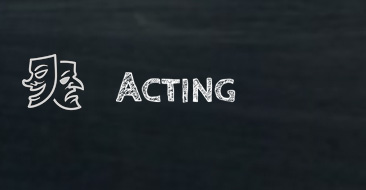
In utilizing this exercise be sure to read this post.
Shape
This is literally how you shape your body, as well as the shapes you create onstage using the environment around you and other bodies. At this point, I will start to create shapes with my own body, then approach a student and ask them to simply mirror me. We then are making the same shapes together. When I love a pose they do, I will tell them to stay that way, while making another shape, demonstrating symmetry and asymmetry. Gesture: How we use our hands, bodies and facial expressions in command. This can be as blatant as waving goodbye to somebody, or as subtle as keeping our arms crossed in front of our bodies when we feel self-conscious.
This is also a good way to draw different attentions on stage, which character or action need be the primary focus. I simply demonstrate by waving, crossing my arms (two highly opposing body languages), then pointing at something or behind them– when they look, I mention how I used gesture to draw their attention elsewhere. Architecture: They love when I demonstrate this one… I tell them that architecture could be the actor literally acting as a set or prop (I then use my own body to act as doorways, columns, etc.) Then, I tell them it could be using the architecture in the room around them. At that point, I jump on a chair, put my hands on the ceiling, run around the pole in the room, flicker the lights, slam the cabinet doors, etc. The architecture is ALL physical surrounding, so it may include light and sound as well. They always get a good laugh when I do this, and so do I.
Spatial Relationship
I select a student to help me demonstrate. I ask that he or she stand somewhere, and stay there without looking at me. I set myself far away, and say, “THIS, has a different meaning…” (I then walk until I am closely behind them) “…than THIS, which has a different meaning…” (I then tap them and have them turn to face me) “…than THIS.” I let them sit and explain how important it is to have distance on stage so that you can become close, or not ever become close. Spatial relationship is also important, not only with people, but also the architecture of where one performs the viewpoint, and even the space beyond that (beyond the room, beyond the building, beyond the earth, etc. We can use our bodies to define this!)
Topography
For this, I demonstrate before we explain. If time permits, I definitely allow them to join me in defining this. I will say, “First, you can only move forward and back. No turning, no looking around.” Then, I allow them to move side-to-side, then side-to-side and forward-and-back. Then, I allow them to move in diagonals, then diagonals and side-to-side and forward-and-back. This all should be done almost as if they were on a grid. Next, I encourage them to travel in circles, spirals, and rounded patterns. I tell them to image that they either have a tail of energy flowing behind them, or perhaps they are leaving golden footprints wherever they travel. Then, I encourage them to use levels in their travel, highs and lows. I let them enjoy “painting the room with their traveling energy” for a while; then let them sit.
I explain that we all have different topographies. Some people may walk with their heads facing the ground, or perhaps up and out. Some people move freely in the movement, while others are slightly more constricted or dramatically constricted. Sometimes, things inspire us to move a certain way. Perhaps when someone who is free-moving is startled, they shell up and their topography changes. Or, someone who is generally shyer with their movements may become free-moving and confident in acting class during a topography exercise!
Exercise Contributed by Anna Smith:
Anna is a graduate of Plymouth State University with a Theatre Arts degree concentrating in Acting & Dramatic Writing. She is currently a teacher at the Bedford Youth Performing Company (BYPC) a non-profit 501c small business company. At BYPC, she currently teaches acting classes, film makers classes, directs spring shows, directs summer camp shows, and participates actively in the “Circle of Giving” program. Circle of Giving is the community outreach service provided by BYPC that helps bring theatre, music and dance to children (and elderly) who may not otherwise have the opportunity.

 Random Item
Random Item